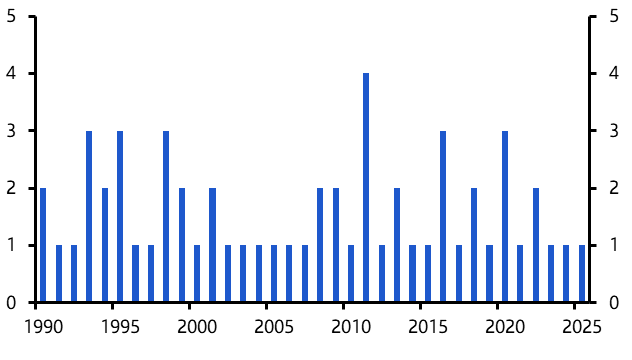The US and Europe adopted very different approaches to providing labour market support during the pandemic but as their economies re-open they appear to be experiencing similar problems: worker shortages, a growing number of unfilled vacancies and wage pressures in some sectors. What’s going on?
Let’s start with the labour market support programmes themselves.
The US government followed a familiar playbook, delivering stimulus checks to households and expanding unemployment benefits for laid-off workers. The size of the overall stimulus package was huge but the labour support elements were similar in design to previous crises.
Governments in Europe took a different approach. They also implemented large stimulus programmes (albeit not as big as that in the US). But labour market support came in the form of furlough or short-time work schemes. These kept workers on payrolls, but governments subsidised all or part of their wages. It was hoped that by keeping workers tied to jobs, firms would be able to ramp up output more quickly once the pandemic eased and restrictions were lifted.
The immediate divergence in labour market outcomes was striking. In the US, the unemployment rate shot up from 3.5% in January 2020 to 14.8% in April as measures to contain the virus crippled activity and firms shed workers. In contrast, the rise in unemployment in the euro-zone and the UK was much smaller (since furloughed workers are still classified as being employed). The unemployment rate in the US has since fallen back sharply but, unlike in Europe, remains some way above its pre-pandemic level. (See Chart 1.)
Chart 1: Unemployment Rate (%)

Source: Refinitiv
However, the similarities between what’s happened in the US and Europe are arguably more interesting. In particular, firms in both are reporting growing difficulties in finding sufficient workers as restrictions on activity are lifted and economies reopen. There is now anecdotal evidence that employers from German restaurants to US metal fabricators are struggling to find workers. And concerns about labour shortages are now starting to show up in small business surveys from both sides of the Atlantic. (See Chart 2.)
Chart 2: Firms reporting labour shortages

Source: Refinitiv
Admittedly, these concerns are particularly acute in the US. But this is not entirely surprising – the US was the first of these economies to lift most coronavirus restrictions and is experiencing a particularly sharp rebound in demand. It was never likely that the 25 million workers that lost their jobs during the pandemic could be put back to work quickly or easily. Add in the fact that expanded unemployment benefits have yet to fully roll off, lingering concerns about returning to the workplace while the virus is still prevalent, and the fact that many schools and childcare facilities remain closed, and it is no surprise that US firms are struggling to find workers.
But this wasn’t supposed to happen in Europe. After all, the whole purpose of the furlough schemes was to keep workers tied to jobs such that firms could simply recall staff once demand recovered.
So why are firms now struggling to fill vacancies? One explanation might be that furloughed workers are tied to the wrong companies. Hospitality and leisure appear to be sectors that are most affected by labour shortages in Europe. They typically have high levels of company churn but this was supressed during the pandemic – firms that would have previously gone bust were propped up, and workers that would typically have moved to new jobs were put on furlough. As a result, new firms that have emerged in these sectors – or existing ones that are experiencing a surge in demand – are now struggling to find workers.
Another explanation is that workers are in the wrong place. Leisure and hospitality firms are disproportionately reliant on migrant workers, many of whom returned to their home countries at the start of the pandemic but have been prevented from coming back by international travel restrictions.
Finally, it’s possible that the design of furlough schemes is also playing a role in exacerbating labour shortages. In most countries, schemes require a qualifying period before employees are eligible for furlough. This could discourage workers that are currently furloughed from seeking new roles, since they would then be ineligible for furlough should new waves of virus cause restrictions to be tightened once again.
There are two common themes in all of this. The first is that calibrating the removal of labour market support with the recovery in labour demand is difficult, particularly when the evolution of the virus remains uncertain. The second, more fundamental, point is that it is difficult to get economies back up to speed from a standing start. Economies are systems, and shocks of the magnitude of the pandemic inevitably introduce frictions. These frictions can manifest themselves in many ways, including in labour shortages, but they should ease over time. Over a longer horizon, labour market conditions will ultimately be governed by the strength of aggregate demand compared to potential supply.
With this in mind, the sheer scale of policy support and the resulting boost to demand means there is far more reason to be concerned about lasting wage and price pressures in the US than there is in Europe. That’s worth keeping in mind if, as seems likely, reports of labour shortages continue to emerge as economies on both sides of the Atlantic re-open.



